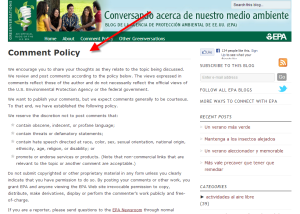- Plan what multilingual content will mean for your org. This entails knowing your language communities. Just as in physical, offline multilingual communities, languages function separately but also intermingle, creole-style. It’s common to present two or more different websites in different languages, as the EPA does with Greenversations. But in some cases it may better suit your community to present hybridized language content. This may be a discussion point with your users — which presentation makes sense to them?
- Consider the access point for bilingual content. One nice thing about US government sites is the simple protocol for accessing Spanish-language content: Take the standard gov URL, such as www.FCC.org, and add /espanol to get the Spanish version. If your group is developing separate content for different languages, maybe you could practice the same simple convention.
- Translate your user interface, particularly key navigation elements, as well as your posted content. Particularly if you’re developing a distinct URL for each language, it’s a hugely worthwhile extra step to translate your static features: navigation buttons, content headings, etc. This is a real shortcoming of the EPA’s Greenversations blog — in the Spanish version, the headings and nav options are still in English. Even if you go the alternate route of embedding a translation feature within one page, that translate button should change your navigation, too. WordPress and other common blogging platforms offer plug-and-play widgets or code that should fit the bill.
- Don’t rely on auto-translation. As a speaker of English, principally, I can feel left out by websites that only offer crude auto-translation features. I’m not offended, but it does suggest that the individual or organization designing the site is mainly channeling their communications elsewhere. While I know real, human translation is expensive, I’ve also seen grassroots groups do amazing work recruiting their communities served into translation projects. If your volunteer base isn’t that engaged, what about partnering with another community group doing ESL or adult education work? Make it a classroom project (and give those class volunteers the credit they deserve with shout-outs and photos on your site).
- Translate your supplementary/reference content. It may not amount to more than a nuisance, but I can imagine serious repercussions for not translating supplementary content about your org and your programs such as disclaimers, site use policies, NPO status, etc. The EPA hasn’t taken that important step with Greenversations.
- Acknowledge your language communities as cultural communities. Providing accurate info in multiple languages may be job #1. But to my mind, the real potential of multilingual web content is to start capturing the excitement of real, breathing language communities. Since language is culture and the reverse, I’m most excited about how my own nonprofits’ websites can begin integrating true patterns of multilingualism, cultural exchange, and hybridization. Easily editable formats such as blogs and wikis are especially promising in this regard. For example, why not incorporate unique blogs and wikis into the different language iterations of your site — spaces for voicing unique community concerns; histories, anecdotes, and recipes; and links, all in whatever languages or mixtures of languages suit your users. I’m not arguing against straightforward translation for many site features. However, I get more jazzed up about the potential of making our online content resonate with how our communities really exist and evolve, swimming as we do in our shifting cultural seas. (Holy cow — doesn’t that sound fancy!)
I wish I could be more concrete on the technical side of translation, but I’m not an expert and, ultimately, it depends on your specific web tools. I am happy to say that I’m engaged in at least one multilingual content project: helping a statewide pedestrian/cycling safety nonprofit create multilingual legal advice for those hit by drivers. (Lord knows bikers/peds in my state can’t always rely on police or the legal system to provide a well-informed defense, even for English language speakers.)
And, while I’m not going to add another bullet above, I did forget to address images and graphics. So there’s another question for your language diversification project: Do your visuals have a language or cultural component that requires “translation”? Let’s talk more about that topic, yes?
*The title? Call it a seriously amateur language mashup… I was aiming for “Tell your story, to everyone” in my own DIY concoction of Spanish, Hindi, and French. My apologies to all!


